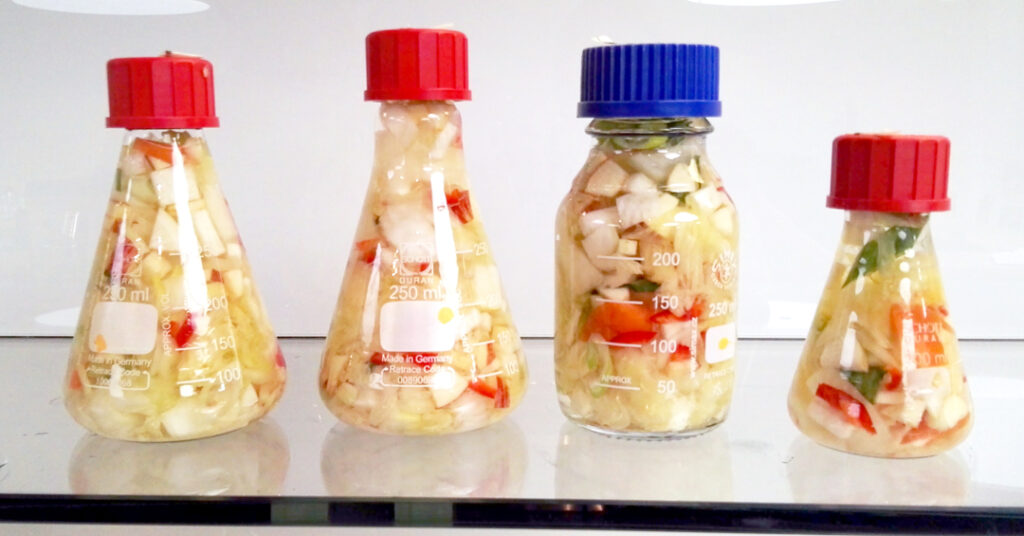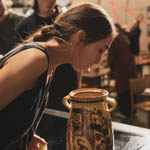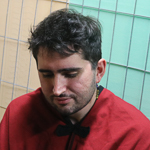Jahan Rezakhanlou observes the lessons of fermentation and biohacking learned from the communal artwork and workshops of Maya Minder.
When I first heard the term “biohacking” from Zürich-based artist and organizer Maya Minder, I was immediately transported back to the cyberpunk comics of my youth, featuring science fictional gene-splicing and post-human hybrids where I.T. and biological structures would collide. However, the reality of biohacking is a more grounded, down-to-earth one, one which Maya insists has been a part of our daily lives for millennia. Before scientific breakthroughs explained the very science of the “biology” we had been hacking.
Fermentation is the most accessible and widely performed example of biohacking. Maya tells me that by fermentation, humans have been playing and experimenting with bacteria, as a practice which 10,000 years ago was believed to be somewhere in-between a form of alchemy or cooking without heat. This all happened before the scientific discovery of microbes in the 1670s by Antoni van Leeuwenhoek or Louis Pasteur who together with Robert Koch founded the “Germ Theory of Disease”. Naturally through the various different scientific breakthroughs in microbiology have human lives progressed exponentially.
However, Maya explores the various cultural and philosophical lessons that lie beyond the scientific approach to fermentation, and thus she seeks to demystify biohacking by exploring fermentation as a creative and collaborative process. Through such workshops in Switzerland, Indonesia and Japan with Dr Marc R. Dusseiller, Maya has sought to introduce people to DIY biotechnology by bridging familiar hands-on fermentation techniques of producing cheese alongside modern biotech tools of gene-editing, in this workshop the CRISPR-Cas9 system, and stimulate a dialogue about how the discussion around gene-editing should be made public, to be discussed bottom-up.

So what are some of the lessons that Maya has explored and discussed in these biohacking workshops?
According to Maya, the key lesson of these workshops is an exploration of community and connection between people in a self-referential way, that would transcend a regular team-building workshop. Fermentation serves as a metaphor for a growing culture, something that is in agitation that can be applied socially. The interaction between microscopic organisms reflects social processes. In response to the current atmosphere of crisis and impoverishment, people in these workshops have even explored the microscopic dynamics of fermentation as the basis of new economic models or systems of communal living. We are each made of trillions of organisms, in the same way, a community exists as a smaller framework than the sum of its parts. Within the framework of our communities, micro and microspheres resemble each other. We can think as a multitude by examining the microscopic organisms that gather for such projects.
Cheese and other fermented foods are alive. This poetically brings to mind an animistic world where the air that we breathe and the food that we eat is in constant movement. We are all connected to the invisible life cycles of microbes.
Fermentation can also help us re-examine the complexities of life within ourselves and how individual humans are all interconnected through the invisible life cycles of microbes. In these workshops, Maya hopes to make people properly realise that we are in constant exchange with our environment. We adapt and evolve on this on a microbial level, since bacteria and viruses are capable of transferring DNA therefore information. Our very language is our manner of communication, where humans share information and knowledge as a transformation of consciousness.
“Language is a virus.”
Laurie Anderson
For Maya in particular the art of fermentation also holds a distinct cultural value. Through her Korean background, fermentation had been a daily ritual growing up as no meal is complete without a serving of kimchi (fermented cabbage) which had to be homemade, due to a lack of it where she grew up in Switzerland. It properly established the communal aspect of fermentation: eating is clearly a communal activity, inviting members from various different walks of life to biohacking workshops. The culture of establishing a series of links between different biological groups, thus communities in its most biological sense, is a key component of biohacking and of Maya’s work.
Ultimately fermentation is one of the purest methods of expressing life, as it literally experiments with the free-living organisms that are present within us all whilst maintaining a cultural and communal message. Maya shows that one can express tour human desire to intervene, manipulate and influence our given path and transform it through our conscious actions, imitating and adapting to biological processes through biohacking. Although most of us do not engage in experimental fermentation as Maya does, many of us already “biohack” without even knowing it where through gardening, breeding, cooking, and brewing we see that it is a question of seeing the term of biohacking much broader and realize the capacities and power we have to act within our given environment.
About Maya Minder
 Maya Minder lives and works in Zurich Switzerland. “Cooking thus transforms us” is the starting point of Minder’s practice. She/He uses cooking and eating as a cultural code and index and uses it as a medium to express social sculptures and storytelling. She held exhibitions and performances during the Soil Assembly, Kochi – Biennale, 2023 India, “Plus que Vivant” Cité International des Arts, 2022, “I am Flower, I am Animal” at Kunsthaus Langenthal and Swiss Art Awards 2023. As a chef, she gives workshops on the art of fermentation together with Michelin guide chef Stefan Wiesner, Luzern, Switzerland. Visit www.soilassembly.ch and algae.muzosa.ch.
Maya Minder lives and works in Zurich Switzerland. “Cooking thus transforms us” is the starting point of Minder’s practice. She/He uses cooking and eating as a cultural code and index and uses it as a medium to express social sculptures and storytelling. She held exhibitions and performances during the Soil Assembly, Kochi – Biennale, 2023 India, “Plus que Vivant” Cité International des Arts, 2022, “I am Flower, I am Animal” at Kunsthaus Langenthal and Swiss Art Awards 2023. As a chef, she gives workshops on the art of fermentation together with Michelin guide chef Stefan Wiesner, Luzern, Switzerland. Visit www.soilassembly.ch and algae.muzosa.ch.
About Jahan Rezakhanlou
 Jahan Rezakhanlou is a Swiss-Iranian multidisciplinary artist, musician and journalist currently undertaking his Master of fine arts at RMIT in Melbourne-Naarm, Australia. His research and practice focus on identifying urban and cultural structures and their impacts on society, having worked with Iranian, Swiss, Hong Kong and Japanese grassroots art collectives both internationally and within Australia. For his Masters, he is examining different egregores within migrant communities in Melbourne-Naarm and how they are sculpted by the urban environment. Follow haikyo_e.jahan
Jahan Rezakhanlou is a Swiss-Iranian multidisciplinary artist, musician and journalist currently undertaking his Master of fine arts at RMIT in Melbourne-Naarm, Australia. His research and practice focus on identifying urban and cultural structures and their impacts on society, having worked with Iranian, Swiss, Hong Kong and Japanese grassroots art collectives both internationally and within Australia. For his Masters, he is examining different egregores within migrant communities in Melbourne-Naarm and how they are sculpted by the urban environment. Follow haikyo_e.jahan


